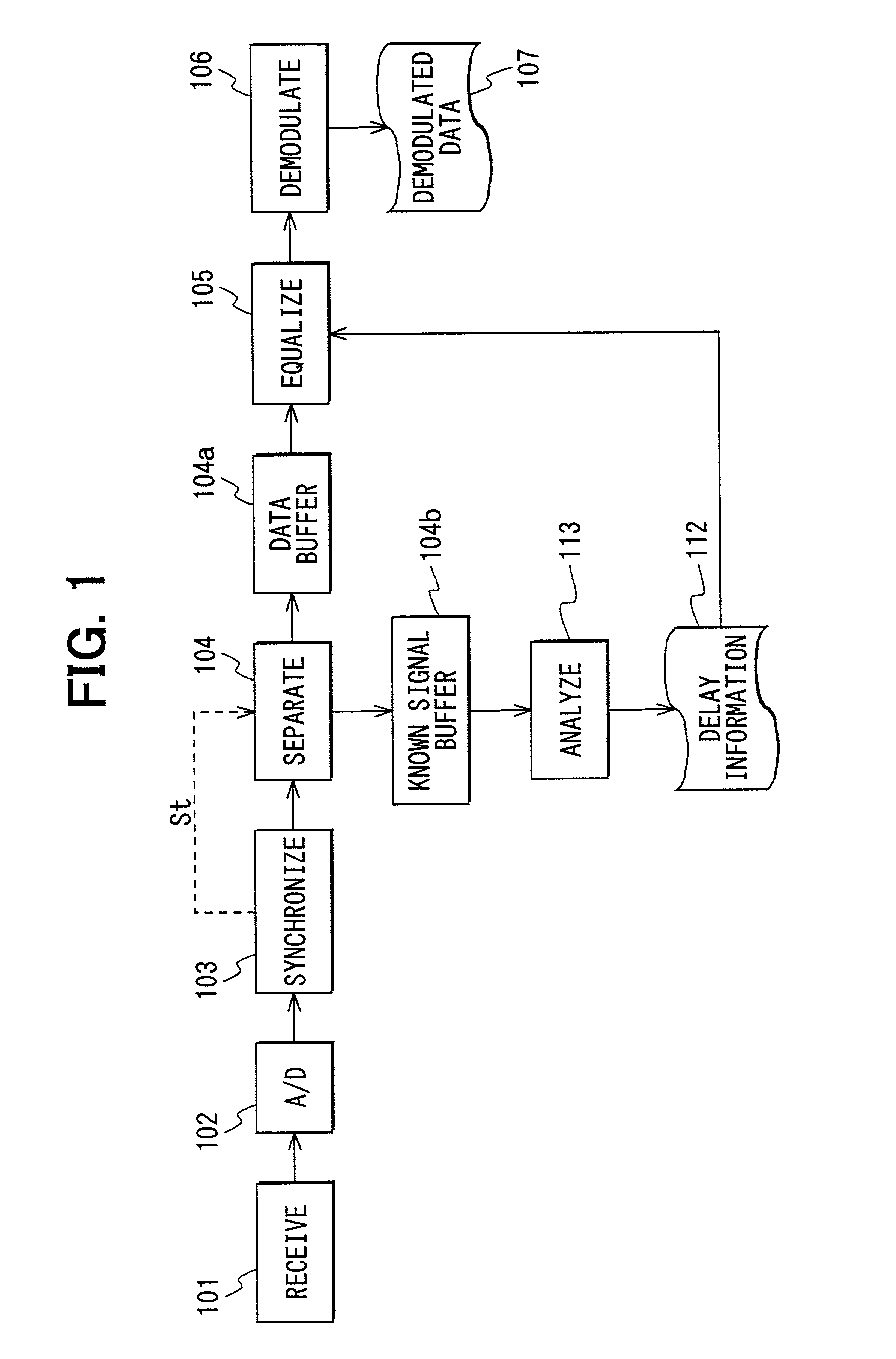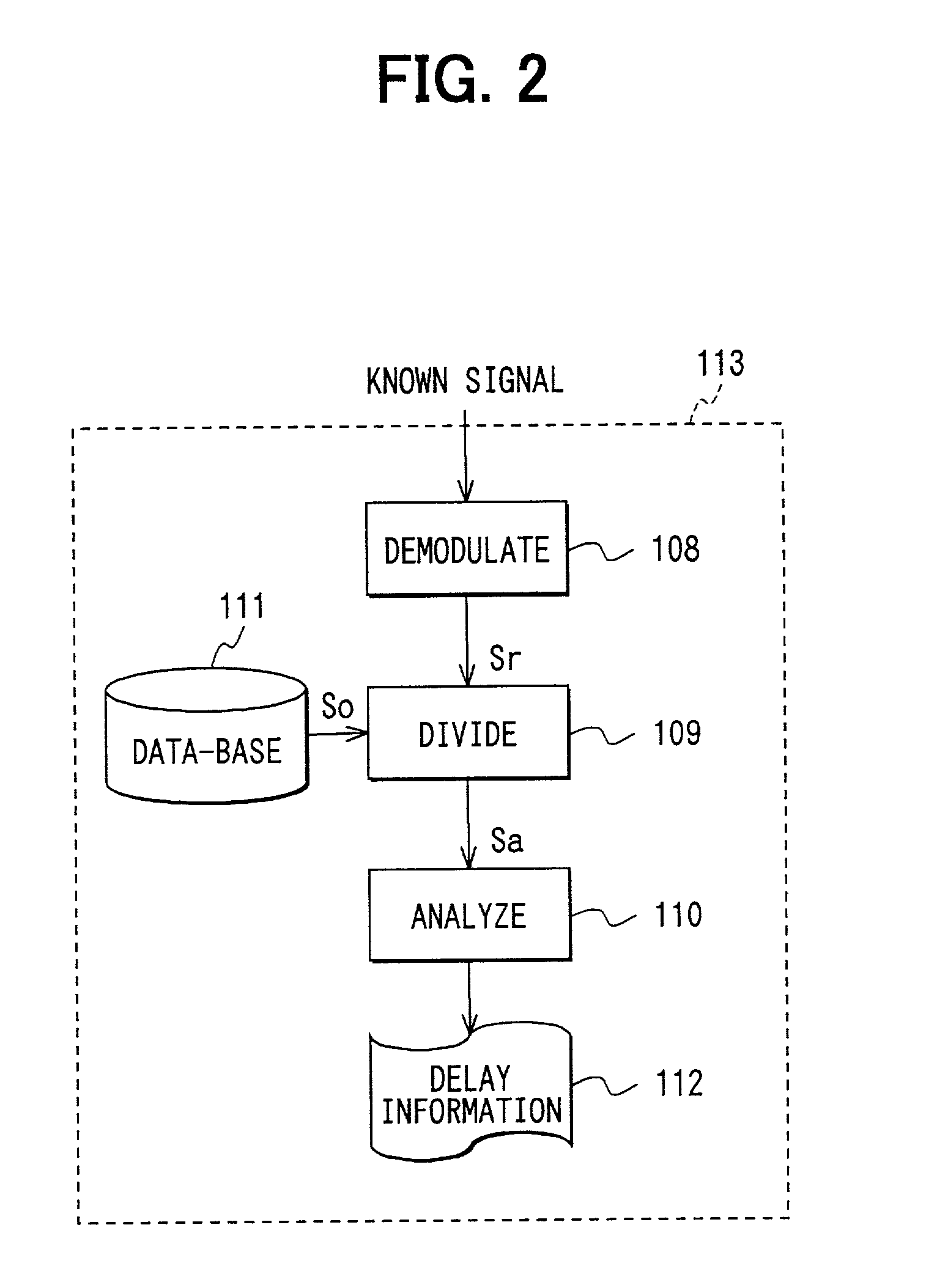Communication device having delay information calculating function
a technology of delay information and communication device, which is applied in the field of communication device having delay information calculating function, can solve problems such as the inability to recognize receiving radio waves, and achieve the effect of improving propagation efficiency
- Summary
- Abstract
- Description
- Claims
- Application Information
AI Technical Summary
Benefits of technology
Problems solved by technology
Method used
Image
Examples
first embodiment
[0029][First Embodiment]
[0030]In FIG. 1 and FIG. 2, there is shown first embodiment of a communication device of the orthogonal multiplexing carrier method in accordance with the present invention. FIG. 1 is a schematic block diagram of circuit in the communication device, while FIG. 2 is a schematic block diagram of circuitry in the delay analyzer circuit shown in FIG. 1.
[0031]The OFDM signals have a number of (N) sub-carriers placed on the frequency axis at a regular interval. The communication device of the orthogonal multiplexing carrier method is referred to as communication device hereinbelow for the sake of simplicity. In the first embodiment, a typical example of usage is assumed for the description of the present invention, wherein the communication device is used in an outdoor wireless communication environment for receiving multiplexed waves. The multiplexed wave includes a plurality of receiving radio waves (delayed waves) arriving at different delayed time from one tran...
second embodiment
[0070][Second Embodiment]
[0071]In the second embodiment, an example is described in which the length (time) of guard interval is optimized by using the computation result of the amount of shift Sa as described in the first embodiment in order to transmit the OFDM signals. In the second embodiment, the data structure of the OFDM signals shown in FIG. 11 is used instead of the data structure shown in FIG. 3.
[0072]In the OFDM signal shown in FIG. 11, a header 13 is added to the data structure shown in FIG. 3. The header 13 is placed between the known signal 10 and the data-1 signal 11. The header 13 has a header guard interval 13a placed at the leader of data sector. Other structure is the same as the data structure shown in FIG. 3. In FIG. 11, data-2 signal 11 is also shown, which signal is omitted in FIG. 3.
[0073]The communication device in accordance with the second embodiment includes, as shown in FIG. 10, a data modulator circuit 122, a synthetic frame generator circuit 123, a dig...
third embodiment
[0091][Third Embodiment]
[0092]In the third embodiment, the arrival direction of each of the receiving radio waves in addition to the delay and receiving power of each of receiving radio waves is determined. FIG. 14 is the overview of this arrangement.
[0093]The communication device shown in FIG. 14 includes a plurality of (M) sets of: an antenna 100, a receiver 101, analog-to-digital converter 102, synchronizer circuit 103, known signal / data separator 104, known signal buffer 104b and divider 109, as well as a database 112, an arrival direction / delay analysis processing circuit 136, and a data demodulator circuit 106. In FIG. 14, the similar or substantially same members are designated with the identical reference numbers to FIG. 1 and FIG. 2. Each of M sets of antennas 100 has the identical characteristics sufficient to constitute an array antenna. Each of M sets of dividers 109 determines fluctuation results SA1, SA2, . . . , SAM, respectively. The database 112 stores the known sig...
PUM
 Login to View More
Login to View More Abstract
Description
Claims
Application Information
 Login to View More
Login to View More - R&D
- Intellectual Property
- Life Sciences
- Materials
- Tech Scout
- Unparalleled Data Quality
- Higher Quality Content
- 60% Fewer Hallucinations
Browse by: Latest US Patents, China's latest patents, Technical Efficacy Thesaurus, Application Domain, Technology Topic, Popular Technical Reports.
© 2025 PatSnap. All rights reserved.Legal|Privacy policy|Modern Slavery Act Transparency Statement|Sitemap|About US| Contact US: help@patsnap.com



